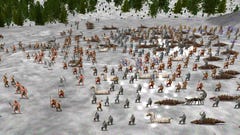Baldur’s Gate 3 on Steam Deck: perfectly playable, once you fix the crashing (Update: the crashing is fixed)
Plus performance, battery and settings tested
Update, and a rather important one at that: The crashing issues I’ve had with Baldur’s Gate 3 on the Steam Deck have been, as far as I can tell, fully fixed. No more collapsing back to the Steam library on startup, and no forcing the use of Proton Experimental – it should launch and work straight away. Valve have even upgraded Baldur’s Gate 3 from Playable to Verified for Steam Deck play, reflecting its newfound handheld-readiness.
This means you can safely ignore the first part of this article, where I whinge about software instability as if it’s the the most heinous atrocity humankind has ever inflicted on itself. All the stuff on general performance, settings, and battery life still applies.
Original article to follow:
Baldur's Gate 3 is launching with a relatively clean bill of technical health, so long as you’re playing it on an honest to goodness Windows PC. Larian Studios’ RPG also happens to have earned Valve’s Playable rating for Steam Deck compatibility, which usually signals a game that’s most fine on the SteamOS handheld – it might just have some small text, or no 16:10 display support.
That Playable certification will have been granted off its early access performance, and now that I’ve wandered around the review build for a few hours, I can confirm that playable it most certainly is, with some especially smart control tweaks to accommodate a lack of mouse and keyboard. Actually getting to that point, however, was a minor nightmare, plagued by hard crashes that took one of the Steam Deck’s most obscure tools to fix. As such, before we get into how Baldur’s Gate 3 runs on the Steam Deck or which settings you should use for it, I hope you’ll afford me a rant.
Because good god, the crashes. Crashes on the main menu. Crashes on the Larian logo screen. Crashes immediately after launching. Crashes before the launcher even loads. Crashes that leave the Steam Deck stuck on a spinning Steam logo, twirling round and round for infinity. Every time, for hours, on both my main 512GB Deck and my backup 256GB model. Stop. Crashing.
Bereft of a clear cause and with the knowledge that it must SURELY work, having earned a Playable badge, I applied all the usual salves. Verifying the files through Steam. Reinstalling the whole thing. I even rolled back to earlier early access builds, and they didn’t work either. Neither did Proton Glorious Eggroll, an upgrade to the Deck’s compatibility software that enables Windows games to run on SteamOS. It turned out this was close to the real remedy, though: after switching to Proton Experimental, the official unstable branch, the danger zone was finally cleared and the Forgotten Realms at last heaved into view on my Deck’s screen.
Larian chucked in one final scare, with a 1GB mini-update to the review build that promptly sent BG3 back into nope-shan’t-boot mode, but another file verification was enough to re-fix it. At the time of writing, I can in fact play Baldur’s Gate 3 on the Steam Deck, albeit still only with the aid of Proton Experimental.
If you want to try yourself, installing the latter is therefore my first and foremost tip: search for Proton Experimental in your Steam library (not the Steam Store, to be clear) and you can download it from there. Once both it and the game are ready, enter BG3’s Properties menu, open the Compatibility tab, then force it to use Proton Experimental when launching. Try to resist subsequently moaning about it for three straight paragraphs on the PC gaming website you work for.
Baldur’s Gate 3 Steam Deck performance and best settings
At least once Baldur’s Gate 3 starts behaving itself, it’s functionally a good fit for the handheld. Maybe not one of the best Steam Deck games ever, but there’s nothing really uncomfortable about it either. In particular, Larian have clearly done the legwork for controller input, completely reshuffling the spell and item grids into radial menus that are far easier to navigate with the Steam Deck’s thumbsticks and shoulder buttons. And, despite the earlier encounters between my skull and the game’s brick wall, BG3 seems perfectly stable after getting up and running.
Stable in the not-crashing sense, anyway. Framerates definitely have their ups and downs, with an emphasis on downs if you aim too high with the quality settings. Even so, you can use the Ultra preset as a starting point, and make just a handful of individual settings changes; these will be enough, I’ve found, to stay above 30fps in the toughest areas and reach as high as 60fps in the more easygoing ones.
- Launcher option: DirectX 11
- Model quality: Low
- Texture filtering: Trilinear
- Shadow quality: Low
- Fog quality: Low
- AMD FSR 1.0: Ultra Quality
- Ambient occlusion: Off
- Everything else: Ultra preset equivalents
These are actually more or less the same as my recommended settings for playing on desktop, and but they work nicely on the Steam Deck too. I tried turning down other individual settings, like texture quality and cloud quality, and none had the performance impact that would make such quality cuts worthwhile. FSR 1.0 is the only must-have addition, as while Baldur’s Gate 3 can often trundle along at playable framerates without any upscaling at all, it’s also prone to dropping well below 30fps during tricky moments. FSR 1.0, while not as pretty as the FSR 2.0 or 2.1 I wish had been implemented instead, will raise that floor and protect against the worst drops.
I also used these settings in my battery life test. On 50% screen brightness and 50% speaker volume, Baldur’s Gate took 1 hour 28 minutes to empty a fully-charged Steam Deck battery through normal play – that’s a pretty quick burn, though also in line with what you can expect from other big, detailed 3D adventures. These end up around the 90 minute mark with uncanny reliability, so BG3’s result is nothing out of the ordinary.
One last tip: get your Steam Deck a microSD card if you haven’t already. The review build weighs in at 122GB, enough to munch over half of the 256GB Deck’s available SSD space, and far too much for the cheapest 64GB model to handle by itself. Baldur’s Gate 3 is a big lad indeed, so make your you’ve got space for it. Plus a couple of extra gigabytes for Proton Experimental, obviously.
Disclosure: Former RPS deputy editor Adam Smith (RPS in peace) now works at Larian and is the lead writer for Baldur's Gate 3. Former contributor Emily Gera also works on it.













